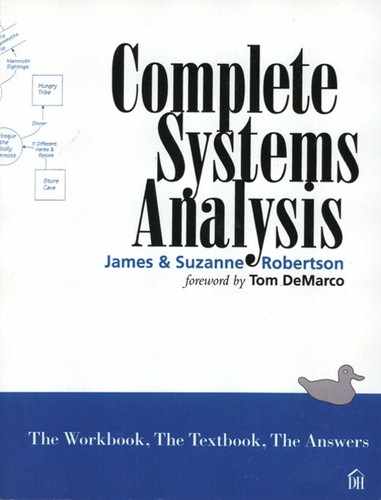4.1. Solutions: Analysis Models
Exercise 1: Woolly Mammoths
The objective of this model is to show the data and the functions of the system. By combining the two processes into one bubble, some important functionality would have been hidden. In this case, we know that the functions are not related because had they been combined, the resulting bubble would have been very difficult to name. Similarly, you could say that the processes do different work, and that the tool makers and the hunters are probably different people. As each of the processes needs to be explained to the people doing the work, showing the functions separately makes the explanations simpler.
If all that is not enough, the case for making them separate bubbles is that the two processes are most likely done at different times. If they are active independently of each other, then your model will portray the system better by showing them separately. Later in the book, when we visit event-response models, you will see how important it is to separate activities that happen at different times.
Exercise 2: Other Uses for the Model
The model had another purpose before it was used to explain the hunting system to the elders. It helped the cavemen analysts themselves to understand the system. Like the cavemen, you cannot complete such a model without understanding the system, but building the model helps you to understand it.
This model also specifies the system in the same way that an architect’s working drawings specify the building to be constructed. Perhaps if you wanted to implement this hunting system in another tribe, the model would be a good starting point. You’d also need some supporting documentation, explaining how each of the bubbles worked. The necessary logic would not be immediately obvious to a new and less wise tribe. For instance, you would need to explain how to analyze brontosaurus habits, and how to make tools. You will read about these explanations, or mini specifications, in Chapter 2.12 Mini Specifications.
Exercise 3: The System Remembers
The piece of system memory, WOOLLY MAMMOTHS FILE, correctly called a data store, provides information for the process SELECT AMBUSH LOCATIONS. You can reasonably expect that anything in the store relates to where the mammoths are traveling. The store is fed by a data flow called MAMMOTH SIGHTINGS coming from the hunting process. You can expect the store to contain such items as WHERE SIGHTED or TRAIL NAME, TIME OF SIGHTING, TO OR FROM THE WATERING HOLE, NUMBER OF MAMMOTHS SIGHTED, and so on. The exact contents of the store will be revealed by a detailed investigation, as you’ll see in Chapter 2.9 Data Dictionary.
